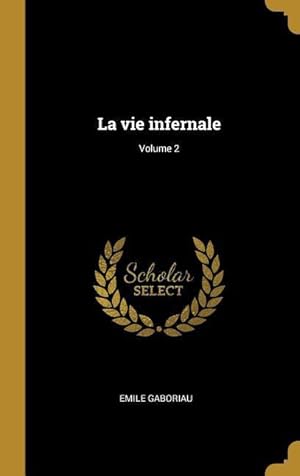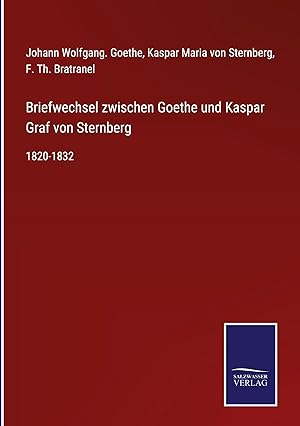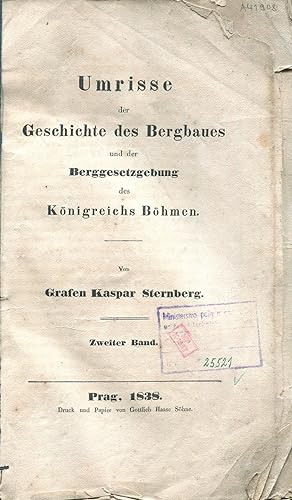sternberg kaspar maria (5 Ergebnisse)
Produktart
- Alle Produktarten
- Bücher (5)
- Magazine & Zeitschriften
- Comics
- Noten
- Kunst, Grafik & Poster
- Fotografien
- Karten
-
Manuskripte &
Papierantiquitäten
Zustand
Einband
Weitere Eigenschaften
- Erstausgabe (1)
- Signiert
- Schutzumschlag
- Angebotsfoto (3)
Land des Verkäufers
Verkäuferbewertung
-
Leben Des Grafen Kaspar Von Sternberg
Verlag: WENTWORTH PR, 2018
ISBN 10: 0274852713ISBN 13: 9780274852710
Anbieter: moluna, Greven, Deutschland
Buch
Gebunden. Zustand: New.
-
Bemerkungen
Verlag: über Menschen und Sitten auf einer Reise durch Franken, Schwaben, Bayern und Oesterreich. Im Jahre 1792. O. O., Dr. [d. i. Zürich, Orell, Gessner, Füßli & Comp.], 1794. 8°. IV, 5-334 S. Mit gest. Titelvign. Pappband d. Zt. mit Rückenschild. Aus der Bibliothek des Konstanzischen Landkapitels Stiefenhofen (bei Immenstadt im Allgäu); mit Exlibris und Namenszug des Dekans Joseph Fidel Prestl (1748-1807) auf dem Vorsatz., 1807
Anbieter: Antiquariat Susanne Koppel, Hamburg, Deutschland
Erstausgabe
"Erste Ausgabe. ? "Keine Leidenschaft führte meine Feder, kein Vorurtheil blendete mich. Wenn ich gleich nur ein Tagebuch schrieb, so hielt ich mich doch zu den Obliegenheiten eines Geschichtschreibers verbunden, und erkannte dabei weder Religion noch Vaterland; wenigstens wird man in der Physiognomie des Buches keines von beyden wahrnehmen" (Vorrede). Die in der aufgeführten Literatur genannte Autorenzuschreibung an Kaspar Maria Graf von Sternberg (Diplomat und Naturforscher; 1761-1838) ist jedoch zweifelhaft. ? Ecke des hinteren Deckels gestaucht; Innendeckel mit altem Exlibris und Namenszug; wenige Kommentare in Bleistift von ca. 1850 in den Rändern, sonst sauberes Exemplar. ? Holzmann/Boh. VII, 1350; Hayn/Got. VIII, S. 422; Bürger (Orell) 585; Engelmann I, S. 490; Th. Sadowsky. Reisen durch den Mikrokosmos. Berlin und Wien in der bürgerlichen Reiseliteratur um 1800. Hamburg 1998. S. 62 u.ö.; VD18 14714256; nicht bei Wurzbach, Palacky, Pfeiffer und Heyd. ".
-
[Foundational work of Paleobotany.] Versuch einer geognostisch-botanischen Darstellung der Flora der Vorwelt. Installments 1 to 4 (out of 8).
Verlag: Leipzig und Prag, in Komm. im Deutschen Museum, in Leipzig bei Fr. Fleischer, 1820, 1821, 1823, 1825., 1825
Anbieter: Antiquariat Stefan Wulf, Berlin, Deutschland
Folio (400 x 255 mm) 12 pp. text, hand-colored engraved plates I-XIII; 33 (+1) pp., plates XIV-XXVI; 39 (+1) pp., with plates XXVII-XXXIX; (part 4: titled on the back as 2 and smaller in size: 390 x 240 mm) 48 pp., I-XLII and plates A-E. Contemporary half calf, with pasted paper on cover (installments 1-3) and with marbled paper (installment 4). Missing the second part of the work, with installments 5-8, published between 1833 and 1838 (with further 50 plates). Overall fine copy though installment 4 with the text evenly browned, but plates overall in perfect condition and in bright original hand-color. Printed Wrappers bound in, but without imprint: "Regensburg: gedruckt bei Christoph Ernst Brenck's Wittwe" on first and second wrapper. Installment 4 without original wrappers (as usual). Rarely offered in complete sets with even libraries worldwide oftenly holding only parts. - First edition of the first part (comprising four installments) of the seminal and fundamental work in paleobotany. It is the first fully scientific and comprehensive survey of fossil plants and of high importance for its more than 600 original diagnoses of genera and species as well as for the illustration of numerous type specimens and is therefore considered today as the beginning of modern palaeobotanical nomenclature. Additionally, it represents a remarkable piece of scientific art, as all the colored engravings were elaborately executed by several painters: Sternberg hired a number of notable artists to depict the specimens in detail, the most important of whom were I. D. Preyssler, E. A. Auinger and F. Both for the first half of the work, and J. Schmedla, J. Rössert and F. X. Fieber on the second (not present here). In the "Tentamen" (installment 4), Sternberg attempted to formulate a new systematic for fossil plants, which was an innovative approach at that time, as previous authors, such as Schlotheim, arranged their fossils according to an artificial inorganic system. Sternberg decidedly rejected the traditional understanding of fossils as mere geological curiosities, and formulated a natural system based on the accepted Linnean classification of living plants. Therefore, the Tentamen represents the first example of modern systematics applied to fossil plants; and this is the way fossil plants are still studied today. - Kaspar Maria von Sternberg (1761 - 1838) is considered the "Father of Paleobotany". He established the Bohemian National Museum in Prague, where his collection of minerals, fossils and plant specimens formed the core collection. Inspired by the newly founded Regensburg Botanical Society (1790), he became an avid naturalist, also establishing a botanical garden in Regensburg. In 1805 he met with Alexander von Humboldt and came under the influence of a number of French paleontologists and botanists. Afterwards, he relocated to an estate in Radnice, Bohemia. There, he created a botanical garden, and conducted important paleobotanical research at recently opened coal mines located in the surrounding areas. "No other collection in the world bears so many, so nice and rare specimens of premium scientific importance" (Alexander v. Humboldt upon his visit of the collection in 1838). Sternberg had gathered and organized a collection that contained 1398 specimens from nearly all parts of Europe, including petrified trunks of lycopods and large blocks showing the leaves of Cordites. Sternberg intended to donate the collection to some sort of public institution. This idea eventually resulted in the foundation of the Patriotic Museum in Prague in 1818 (later called the National Museum). Rarely offered in complete sets with even libraries worldwide oftenly holding only parts. - First edition of the first part (comprising four installments) of the seminal and fundamental work in paleobotany. It is the first fully scientific and comprehensive survey of fossil plants and of high importance for its more than 600 original diagnoses of genera and species as well as for the illustration of numerous type specimens and is therefore considered today as the beginning of modern palaeobotanical nomenclature. Additionally, it represents a remarkable piece of scientific art, as all the colored engravings were elaborately executed by several painters: Sternberg hired a number of notable artists to depict the specimens in detail, the most important of whom were I. D. Preyssler, E. A. Auinger and F. Both for the first half of the work, and J. Schmedla, J. Rössert and F. X. Fieber on the second (not present here). In the "Tentamen" (installment 4), Sternberg attempted to formulate a new systematic for fossil plants, which was an innovative approach at that time, as previous authors, such as Schlotheim, arranged their fossils according to an artificial inorganic system. Sternberg decidedly rejected the traditional understanding of fossils as mere geological curiosities, and formulated a natural system based on the accepted Linnean classification of living plants. Therefore, the Tentamen represents the first example of modern systematics applied to fossil plants; and this is the way fossil plants are still studied today. - Kaspar Maria von Sternberg (1761 - 1838) is considered the "Father of Paleobotany". He established the Bohemian National Museum in Prague, where his collection of minerals, fossils and plant specimens formed the core collection. Inspired by the newly founded Regensburg Botanical Society (1790), he became an avid naturalist, also establishing a botanical garden in Regensburg. In 1805 he met with Alexander von Humboldt and came under the influence of a number of French paleontologists and botanists. Afterwards, he relocated to an estate in Radnice, Bohemia. There, he created a botanical garden, and conducted important paleobotanical research at recently opened coal mines located in the surrounding areas. "No other collection in the world bears so many, so nice and rare specimens of premium scientific importa.
-
Briefwechsel zwischen Goethe und Kaspar Graf von Sternberg
Verlag: Salzwasser-Verlag, 2021
ISBN 10: 3752548614ISBN 13: 9783752548617
Anbieter: moluna, Greven, Deutschland
Buch
Zustand: New. KlappentextrnrnUnveraenderter Nachdruck der Originalausgabe von 1866.
-
Umrisse der Geschichte des Bergbaues und der Berggesetzgebung des Königreichs Böhmen. Zweiter Band
Verlag: Prag: Druck und Papier von Gottlieb Haase Söhne 1838, 1838
A rare book about the history of mining and mining law in the Kingdom of Bohemia; the second volume. Written by Kaspar Maria Graf von Sternberg (1761-1838), a Bohemian theologian, mineralogist, geognost, entomologist and botanist. The frontispiece (with engravings of two seals) is missing; no page is missing. /// Paperback, X+351 pp., 8° (15 x 23 cm), deckle edges, cover heavily worn and faded, with two paper labels, chips and tears, large parts missing, title leaf worn and chipped, with ownership stamp, pages dog-eared, yellowed (or slightly tanned), with edge wear, ca. 20 pages have minor pencil marking or underlining, several leaves detached, one leaf has two small tears, last leaves worn and chipped (but text not affected), frontispiece missing, condition: fair Book Language/s: German.





